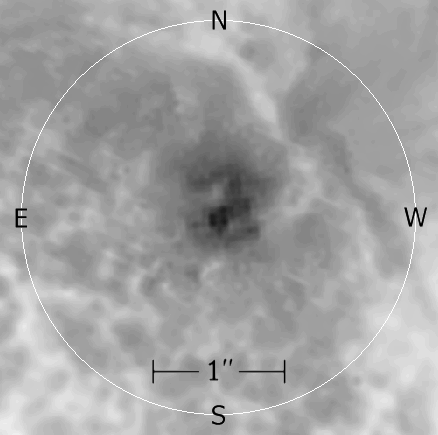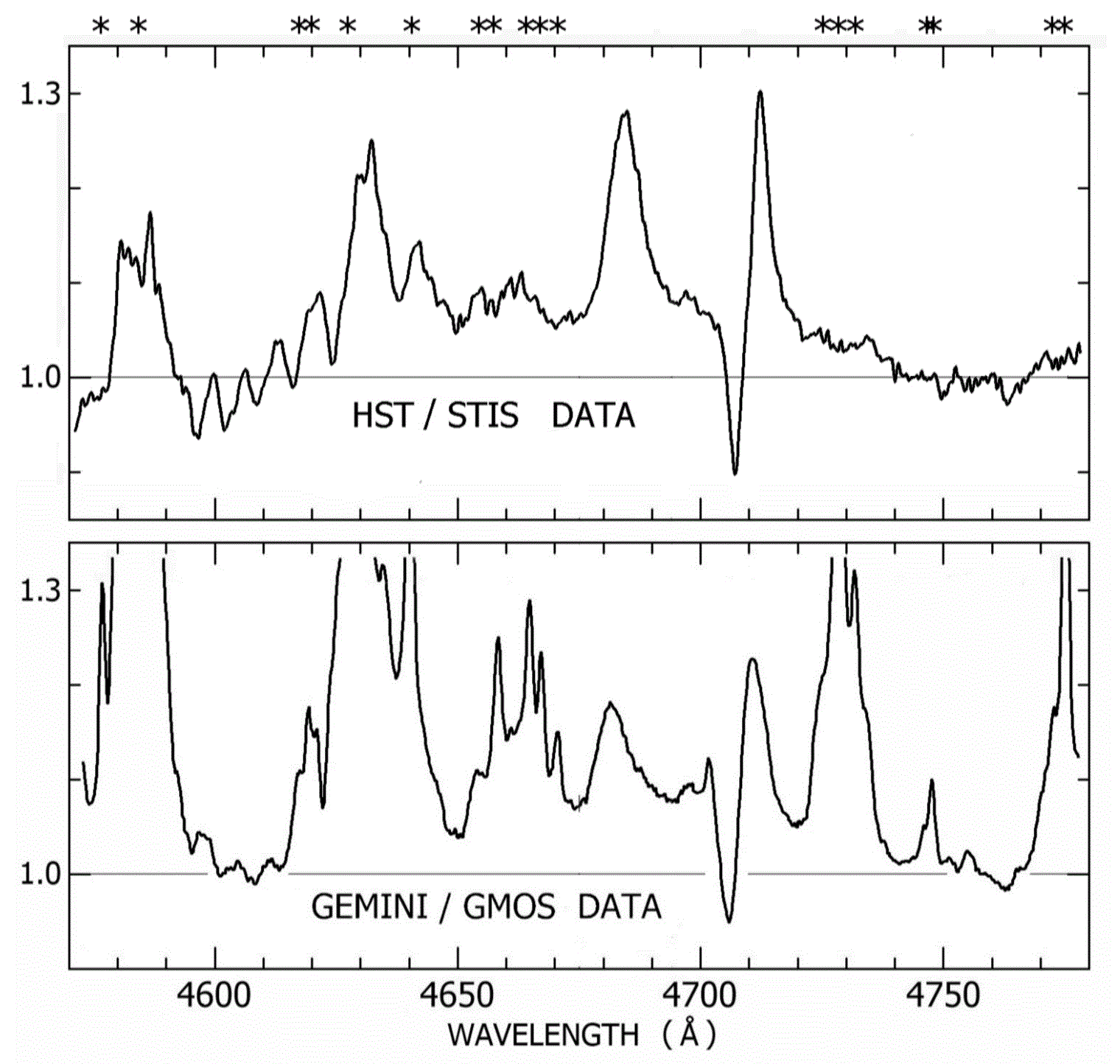Why Eta Carinae Needed the Hubble Space Telescope
At UV to red wavelengths, even the largest ground-based telescopes cannot separate η Car, the central star, from the complex material near it. And, of course, ground-based instruments cannot see ultraviolet λ < 300 nm.
Before the first HST observations in 1991, the observed spectrum was an inseparable mixture of disparate sources. For instance, one group of researchers modeled η Car's bright Hα emission line as a sum of eight components []! We know today that there are five or six main effects:
- The star's dense wind produces a Doppler-broadened Hα emission line,
- Thomson scattering adds extended wings to the line shape,
- emission on one side of the star is affected by a shocked region due to a companion star's less dense wind,
- sometimes the primary outflow also causes P Cyg absorption on the short-wavelength side,
- slow-moving ejecta about 0.3 arcsec from the star create a narrower superimposed Hα line, and
- at some times a narrow blue-shifted absorption line originates in other ejecta farther out.
The story developed as follows. First, in the 1980s, G. Weigelt et al used speckle techniques to discover some mysterious objects near the star, too close to it for normal images to show []. At first those blobs or "knots" were suspected to be companion stars, because they seemed comparable to the star in brightness; ejected gas cannot normally be that bright. But HST later showed that they are indeed gas ejected from the star around 1900, roughly 50 years after the Great Eruption []. (The brightness paradox was caused by two factors. First, localized dust makes the star appear fainter than expected, but doesn't obstruct our view of the blobs. Second, the Weigelt blobs have extraordinary spectra with thousands of emission lines.)
Figure 1 is an early HST image obtained in 1995, showing the Weigelt knots northwest of the star, i.e., to the upper right of it []. All ground-based spectroscopy and photometry of η Car includes the Weigelt knots in addition to the star. HST first observed η Car's spectrum in 1991 []. It revealed for the first time the central star, separated from the Weigelt knots. As Fig. 2 shows, most of the spectral lines in ground-based data represent diffuse ejecta, not the star. The figure's lower panel is basically what a large ground-based telescope can resolve, including a dense jungle of blended narrow lines from the Weigelt blobs and other gas. HST data on just the star (upper panel) led to analyses of the wind parameters [,] and, unexpectedly, to most of our information about dramatic changes in the star during 1998--2015 (see below).STIS, the Space Telescope Imaging Spectrograph, attained better spectral resolution beginning in 1998. Figure 3 shows an example from 2014, compared to an unusually good ground-based spectrum obtained with the Gemini telescope a few years earlier. Note the extraneous features in the Gemini data, for instance near 4748 and 4774 AA. Eighteen of them are marked with asterisks at the top of the figure, and this narrow wavelength interval includes only about 5% of the near-UV-to-far-red spectrum. Thus a ground-based spectrum includes hundreds of features that have practically nothing to do with the star.
These facts help to explain why the star's rapid development after 1998 was revealed by HST rather than normal telescopes [,,]. For years some researchers doubted the changes [,,,], partly because the extraneous features made the stellar spectrum less clear in their ground-based spectra. Moreover, the amount of contamination depends on atmospheric seeing (see Fig.1), so illusory spectral fluctuations can occur between different observing nights. In summary, spatial resolution better than 0.2 arcsec is needed for reliable spectroscopy of η Car. So far, only HST has been able to do that.
Access to the UV (< 300 nm) is another benefit, so obvious that we won't dwell on it here. This star's wind produces a dense forest of Fe II, etc., absorption lines which vary with the companion star's orbital phase, plus bright high-excitation emission features at λ < 200 nm. IUE detected these features in the 1980's, but only with poor spatial resolution; so HST has been necessary in this respect too.
Finally, we should mention that η Car and HST/STIS were superbly matched to each other. STIS had just the right spatial and spectral resolution, and Eta is so bright that many wavelength intervals could be sampled in rapid succession. Some of the resulting data probably hold world records for angular plus spectral resolution on any complex target outside the solar system. If there were a contest for rate of separate scientific results per HST orbit, only a handful of other objects can compete with η Car.



